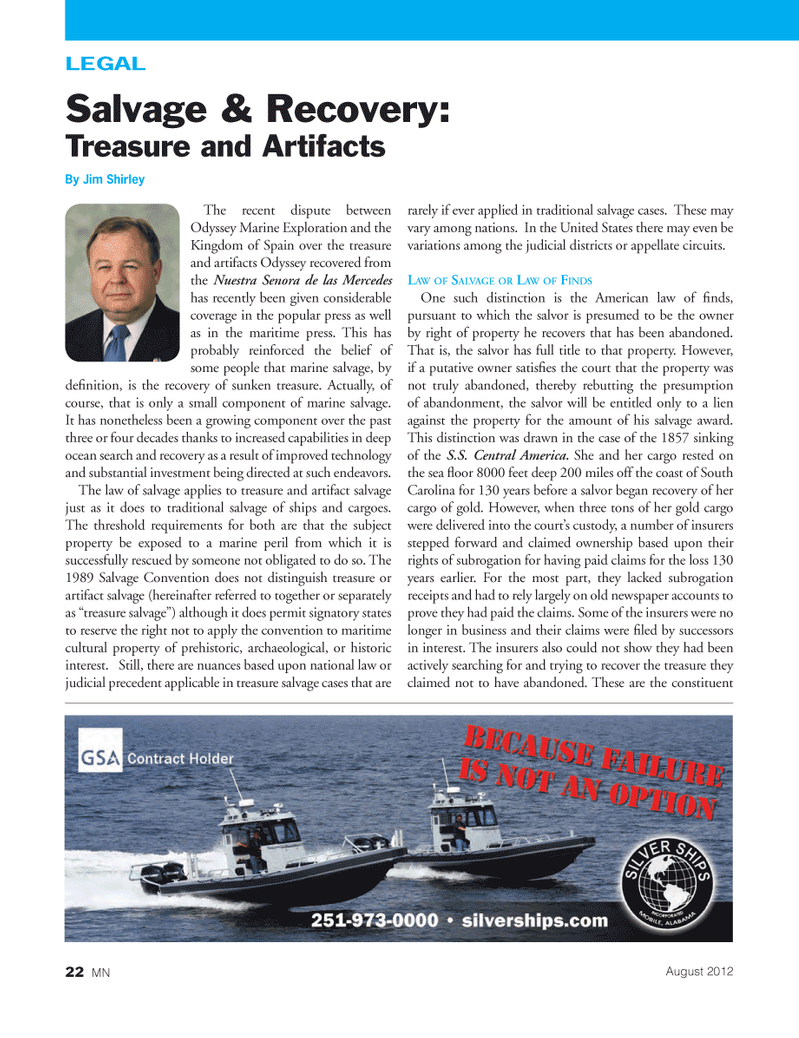
Page 22: of Marine News Magazine (August 2012)
Salvage & Recovery
Read this page in Pdf, Flash or Html5 edition of August 2012 Marine News Magazine
The recent dispute between Odyssey Marine Exploration and the Kingdom of Spain over the treasure and artifacts Odyssey recovered from the Nuestra Senora de las Mercedes has recently been given considerable coverage in the popular press as well as in the maritime press. This has probably reinforced the belief of some people that marine salvage, by deÞ nition, is the recovery of sunken treasure. Actually, of course, that is only a small component of marine salvage. It has nonetheless been a growing component over the past three or four decades thanks to increased capabilities in deep ocean search and recovery as a result of improved technology and substantial investment being directed at such endeavors. The law of salvage applies to treasure and artifact salvage just as it does to traditional salvage of ships and cargoes. The threshold requirements for both are that the subject property be exposed to a marine peril from which it is successfully rescued by someone not obligated to do so. The 1989 Salvage Convention does not distinguish treasure or artifact salvage (hereinafter referred to together or separately as Òtreasure salvageÓ) although it does permit signatory states to reserve the right not to apply the convention to maritime cultural property of prehistoric, archaeological, or historic interest. Still, there are nuances based upon national law or judicial precedent applicable in treasure salvage cases that are rarely if ever applied in traditional salvage cases. These may vary among nations. In the United States there may even be variations among the judicial districts or appellate circuits. LAW OF SALVAGE OR LAW OF FINDSOne such distinction is the American law of Þ nds, pursuant to which the salvor is presumed to be the owner by right of property he recovers that has been abandoned. That is, the salvor has full title to that property. However, if a putative owner satisÞ es the court that the property was not truly abandoned, thereby rebutting the presumption of abandonment, the salvor will be entitled only to a lien against the property for the amount of his salvage award. This distinction was drawn in the case of the 1857 sinking of the S.S. Central America. She and her cargo rested on the sea ß oor 8000 feet deep 200 miles off the coast of South Carolina for 130 years before a salvor began recovery of her cargo of gold. However, when three tons of her gold cargo were delivered into the courtÕs custody, a number of insurers stepped forward and claimed ownership based upon their rights of subrogation for having paid claims for the loss 130 years earlier. For the most part, they lacked subrogation receipts and had to rely largely on old newspaper accounts to prove they had paid the claims. Some of the insurers were no longer in business and their claims were Þ led by successors in interest. The insurers also could not show they had been actively searching for and trying to recover the treasure they claimed not to have abandoned. These are the constituent LEGALSalvage & Recovery: Treasure and Artifacts By Jim Shirley22 MNAugust 2012

 21
21

 23
23
